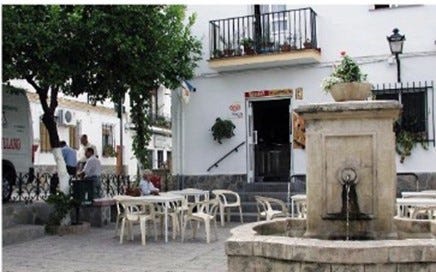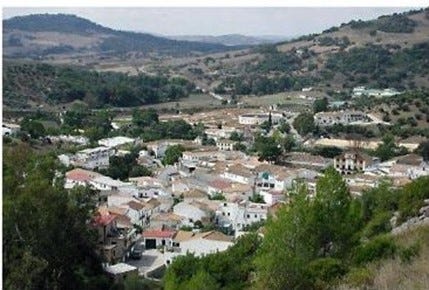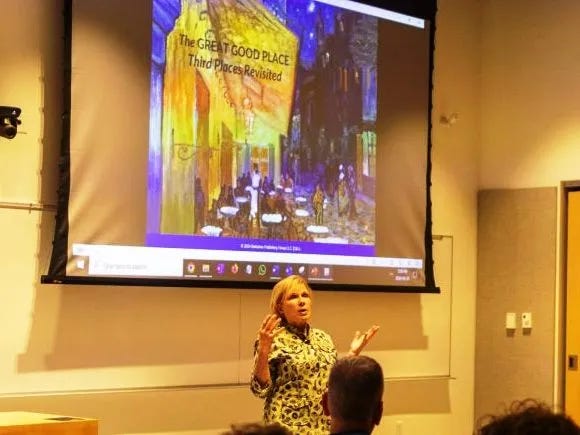Research on third places has led me to an academic field called phenomenology, and to writers who are helping me understand the importance of place. One of them, Barbara Erwine, sent me an article that I’d like to share today.
Barbara is the author of a wonderful book, Creating Sensory Spaces: The Architecture of the Invisible (Routledge), which is helping me round out my discussion of third places. Her article, “Counting Community,” is an account of a day she and her family spent counting the comings and goings in a town square in a small town in Spain. Reading it left me wondering if the US actually has town squares. The term is thrown around all the time, but I’m not sure they exist here. Cities have public squares. Towns have village greens and Main Streets. But do we Americans have, or have we ever had, anything quite like the Spanish town square Barbara describes below?
I’m especially curious because “town square” has been used metaphorically by the Silicon Valley crowd since at least the early 2000s. The article “Building Virtual Communities” in the Encyclopedia of Community, published in 2004, opens, “The Internet is a virtual town square, as people go online to satisfy their personal, social, and professional needs.”
“Public square” is a variation, and I learned today that it’s the name of a right-wing “anti-woke” shopping website, PublicSquare.com. I checked my own home address and also the address in Cupertino (heart of the Silicon Valley) where I grew up. Not a single listing.
You can click here for a PDF of Barbara Erwine’s 4-page article, published in Architectural Phenomenology. I include an extract below, with Barbara’s permission.
From “Counting Community” by Barbara Erwine:
The word plaza stems from the same etymological base as the word place, which has its roots in the Latin words placea, platea, and planta. Placea means a specific spot; platea connotes open space; and planta means sole of the foot. Putting them together, a plaza refers to a particular open space where one plants one’s feet and stands. I’m fascinating by such word explorations. They help ground me when I’m traveling.
The plaza where we’ve planted our feet this morning has the casual feel of a space molded over time with the touch of many hands. It’s not a true square, but lopped off at one corner to accommodate the hillside contours. Street tees mingle overhead, their lacey fringe creating a delicate border around the patch of predawn sky above us. The whitewashed building nudging up against the south edge houses a bar. I realize that it’s going to factor heavily in our count. In our first ten minutes, I record six people entering that establishment. . . .
7.00am Scanning the plaza, I wonder what makes these white stucco houses cozy up around this opening in the dense fabric of the village? . . . I imagine the houses crowding in around us as a gelatinous world (think tapioca pudding) and wonder what prevented them from overrunning the plaza’s borders and filling in the void.
Throughout millennia, the town square has served as the community living room—a place to exchange good and gossip, hold festivals and celebrations, create unity, and flaunt political strength. . . .
On this chilly morning, however, our little square in this whitewashed Andalusian hilltown of El Bosque holds less grand ambitions. It’s a sleepy cousin to the political upheavals elsewhere and seems to doze through these early morning hours. Rimmed by narrow streets on its northern, eastern, and western edges, it has all the requisite trappings of a neighborhood gathering place. A marble fountain marks its center, and a low stone wall marks its perimeter while allowing non-committal conversations to straddle its edge. A smattering of white metal chairs and small round tables accommodate its visitors. . . .
A village square is a place to watch and be watched. Michael Webb, visionary architect and connoisseur of urban spaces, writes of how “the actors and decor have changed over the centuries, but the need for a stage has remained constant.” Our unassuming plaza stirs an enchantment of belonging to something larger. This place is a rich mix of the familiar and the unexpected. The usual star players, the supporting actors, and the surprise cameos add to the allure of this familiar territory. The predictable idiosyncrasies of fellow actors—some endearing, others irritating—tie the people who live here to this place that they intimately know and, through knowing, come to love in that sometimes begrudging way only the familiar can elicit. . . .
I volunteer for the first walk. The town is now fully awake. Sun washes east-west streets with watery light and fills north-south ones with inky shadows. White corridors of connected houses guide my wanderings in a convoluted labyrinth along the hillside until I reach a dead end and must retrace my way back, alternating through sun and shadow. I pick up a prickly pear fruit from the road and stop to ask a woman sitting on the plaza wall whether it is ripe to eat. Punching her thumb into the side of the ruby fruit, she laughs and says it’s rotten. She then hails a passing car, waves the fruit in the air, and yells something at the driver. She shoos me away saying, “Momento,” and throws the fruit into the shrubbery. . . .
Settling back into my chair, I notice the man from the car strolling toward us with a small plastic bag in his hand. When he reaches us, he rolls three peeled prickly pears onto one of the plates on our table, slices them with a knife and offers up this tender treat to Annie, Paul, Francisco, and me. I bit into the fragrant pink flesh and resume the count as Paul picks up in Spanish, weighing the merits of the succulent fruit, the beautiful morning, the lazy dog at the curb.
Bill Gates is quoted as saying in 2010, “The Internet is becoming the town square for a global village of tomorrow.” In 2017, Apple announced that “Apple stores, around 400 of them, will be redesigned to become ‘town squares’ where people can use free wifi, learn more about their Apple products and hang out with friends.” And when Elon Musk bought Twitter and renamed it X, he was talking about how it would be the “digital town square.”
Town square? Speakers Corner? Or perhaps the Coliseum?








